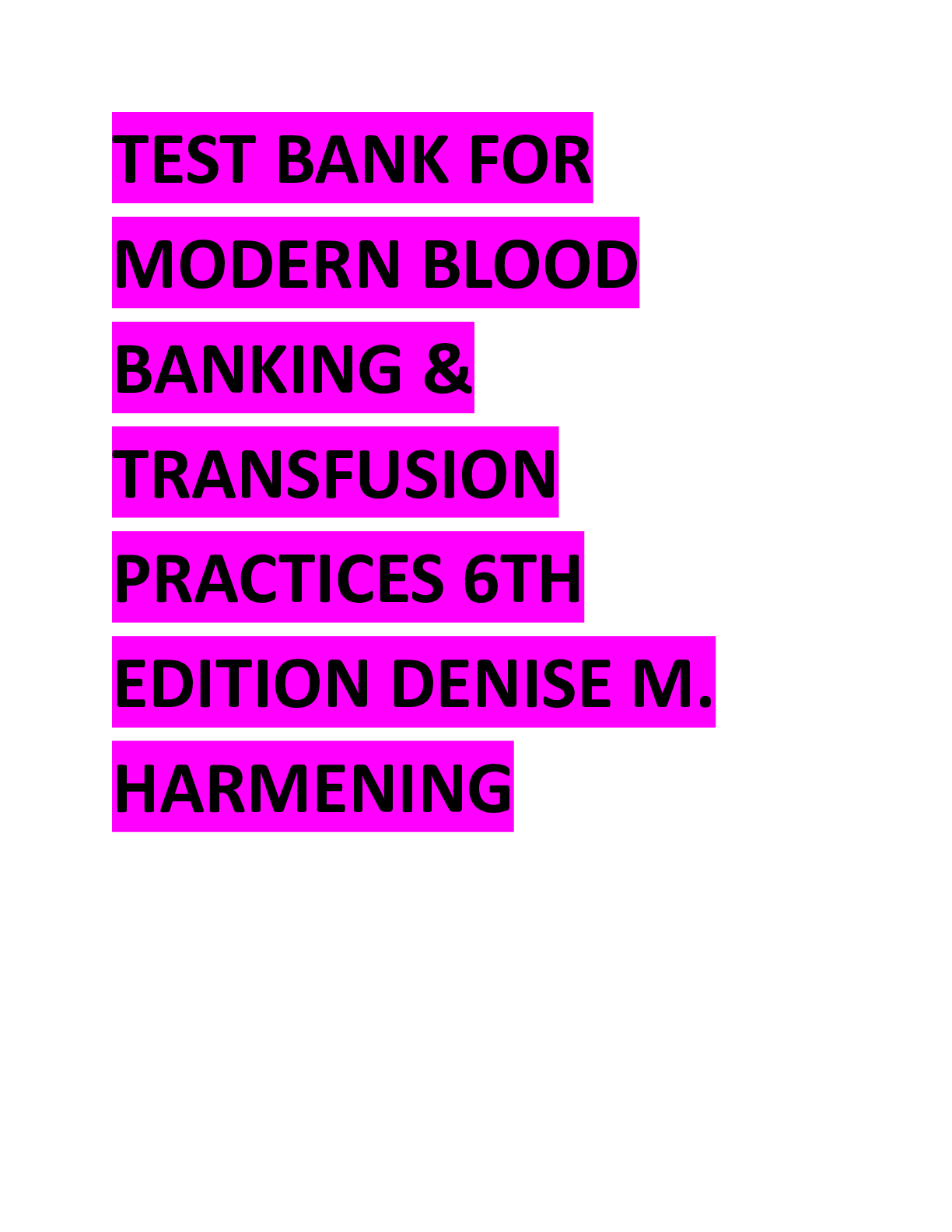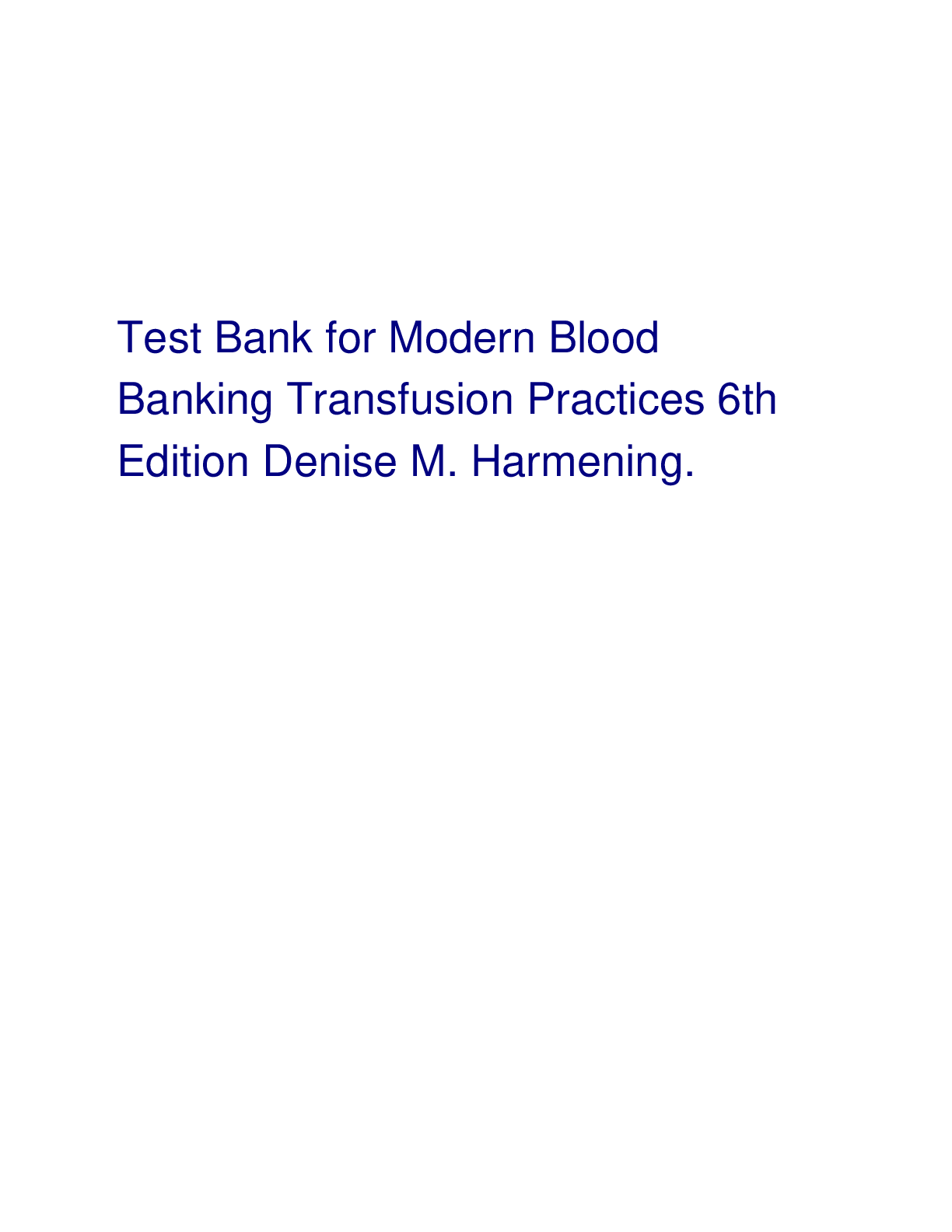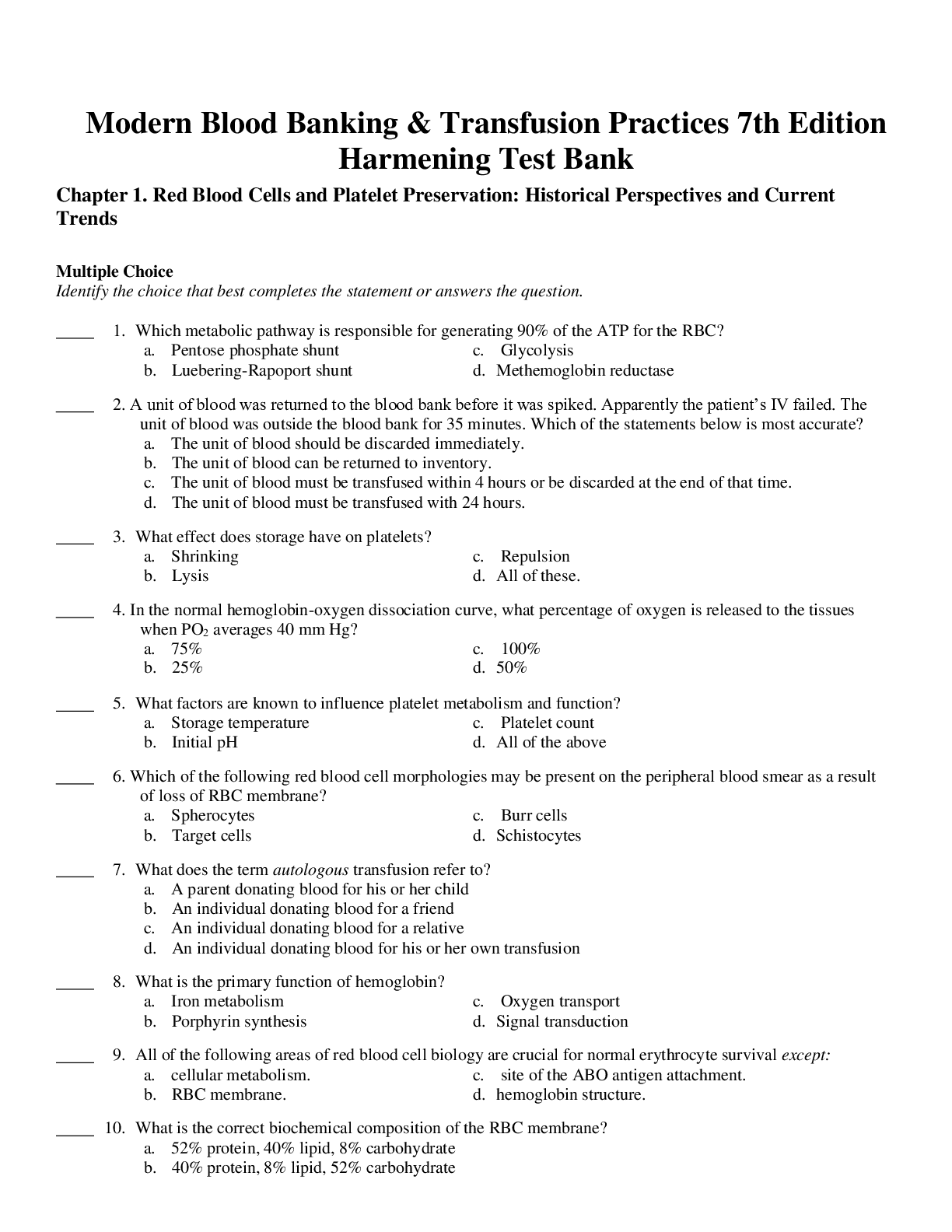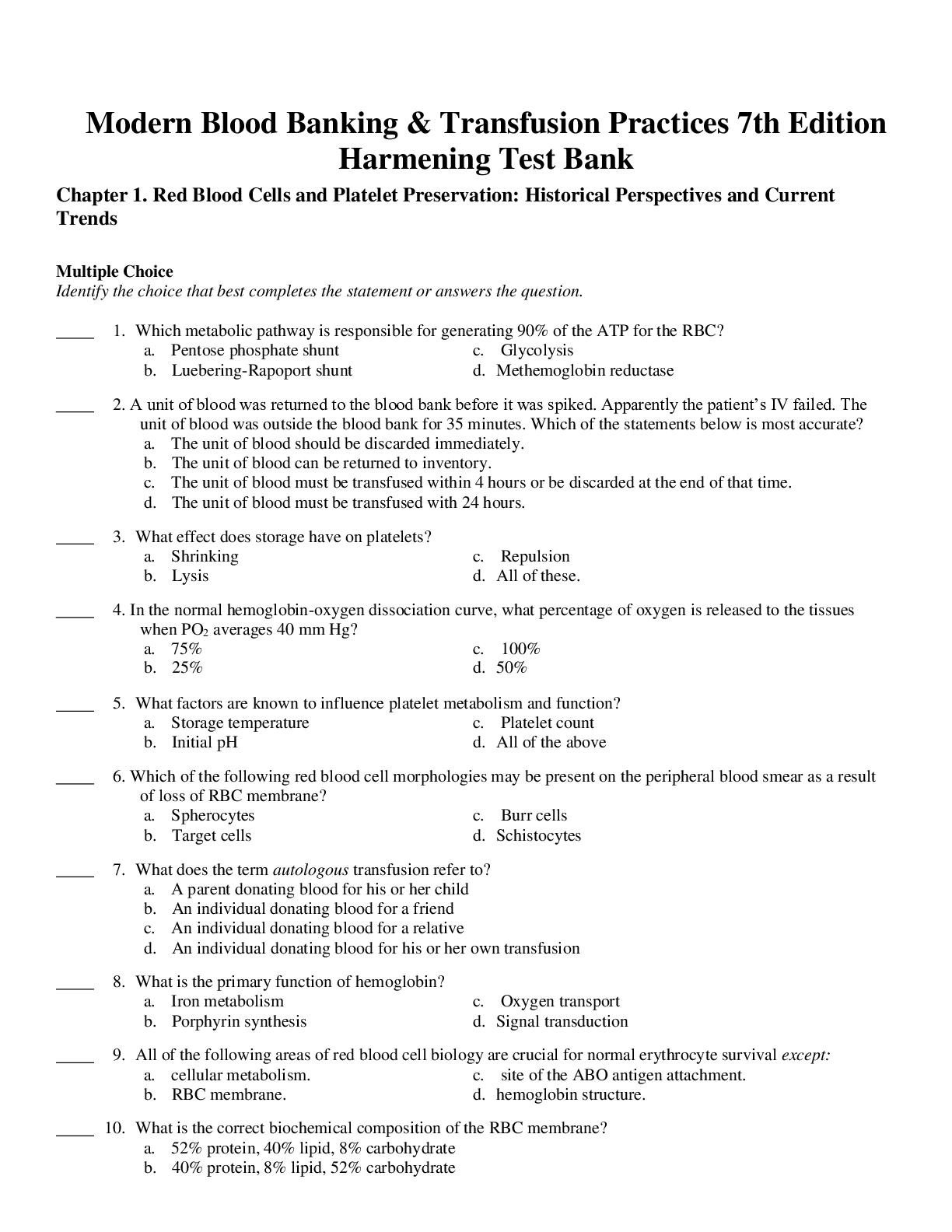*NURSING > TEST BANK > Modern Blood Banking Transfusion Practices 6th Edition | Modern Blood Banking Transfusion Practices (All)
Modern Blood Banking Transfusion Practices 6th Edition | Modern Blood Banking Transfusion Practices
Document Content and Description Below
Modern Blood Banking Transfusion Practices 6th Edition Modern Blood Banking Transfusion Practices* ANTIGENS Antigen RBC Antigen Antigen Antigen Antigen Antigen ISBT Freq. % Expression Distrib. Dem... onstrates Modification System Name Name W B at Birth Plasma/RBC Dosage Enzyme/Other Rh Kell Duffy *This chart is to be used for general information only. Please refer to the appropriate chapter for more detailed information. AET = 2-aminoethylisthiouronium bromide; ↑ = enhanced reactivity; → = no effect; ↓ = depressed reactivity; occ = occasionally; CGD = chronic granulomatious disease; HDN = hemolytic disease of the newborn; HTR = hemolytic transfusion reaction; NRBC = non-red blood cell; RBC = red blood cell; WBC = white blood cell; ZZAP = dithiothreitol plus papain. • No human antibody to FY6 has been reported. † It has been found that Kx is inherited independently of the Kell system; consequently it is no longer referred to as K15. D CE ce ce/f Ce Cw GV VS K k Kpa Kpb Jsa Jsb †Kx FYa FYb RH1 RH2 RH3 RH4 RH5 RH6 RH7 RH8 RH12 RH10 RH20 KEL1 KEL2 KEL3 KEL4 KEL6 KEL7 — FY1 FY2 FY3 FY5 •FY6 85 70 30 80 98 64 70 1 86 1 1 9 98.8 2 99.9 .01 99.9 99.9 65 80 100 100 100 92 34 21 97 99 rare 30 32 rare 100 rare 100 20 99 99.9 10 23 ? strong strong strong strong strong strong strong strong strong strong strong strong strong strong strong strong strong weak strong strong strong ? ? RBC only RBC only RBC only RBC only RBC only RBC only RBC only RBC only RBC only RBC only RBC only RBC only RBC only RBC only RBC only RBC only RBC only RBC low RBC only RBC only RBC only ? RBC only no yes yes yes yes no no yes no no no occ occ occ occ occ occ occ yes yes no no ? Enz. ↑ Enz. ↑ Enz. ↑ Enz. ↑ Enz. ↑ Enz. ↑ Enz. ↑ Enz. ↑ Enz. ↑ Enz. ↑ Enz. → AET+ ↓ ZZAP ↓++ Enz. → AET+ ↓ ZZAP ↓++ Enz. → AET+ ↓ ZZAP ↓++ Enz. → AET+ ↓ ZZAP ↓++ Enz. → AET+↓ ZZAP ↓++ Enz. → AET+ ↓ ZZAP ↓++ Enz. → AET+ ↓ ZZAP ↓++ Enz. ↓ AET ↓ ZZAP ↓ Enz. ↓ AET ↓ ZZAP ↓ Enz. → AET → ZZAP → Enz. → AET → ZZAP → Enz. ↓ AET → ZZAP ↓ANTIBODIES Immunoglobin Clinical Serology Comp. Class Optimum Significance Stimulation Saline AHG Binding IgM IgG Temperature HTR HDN Comments RBC RBC RBC/NRBC RBC RBC RBC RBC RBC/NRBC RBC RBC RBC RBC RBC RBC RBC RBC RBC RBC RBC RBC RBC RBC occ occ occ occ occ occ occ occ occ occ occ occ no no rarely rarely no no rare rare no no yes yes yes yes yes yes yes yes yes yes yes yes yes yes yes yes yes yes yes yes yes yes no no no no no no no no no no no some no no no no no no some some rarely ? occ occ occ occ occ occ occ occ occ occ occ occ rarely no rarely rarely no occ rare rare no no yes yes yes yes yes yes yes yes yes yes yes yes yes yes yes yes yes yes yes yes yes yes warm warm warm warm warm warm warm warm warm warm warm warm warm warm warm warm warm warm warm warm warm warm yes yes yes yes yes yes yes yes yes yes yes yes yes yes yes yes yes yes yes yes yes yes yes yes yes yes yes yes yes yes yes yes yes yes yes yes yes yes yes yes yes yes Very rarely IgA anti-D may be produced; however, this is invariably with IgG. Anti-E may often occur without obvious immune stimulation. Warm autoantibodies often appear to have anti-e-like specificity. Anti-Cw may often occur without obvious immune stimulation. Antibodies to V and VS present problems only in the black population, where the antigen frequencies are in the order of 30 to 32. Some antibodies to Kell system have been reported to react poorly in low ionic media. Kell system antigens are destroyed by AET and by ZZAP. Anti-K1 has been reported to occur following bacterial infection. The lack of Kx expression on RBCs and WBCs has been associated with the McLeod phenotype and CGD. Fya and Fyb antigens are destroyed by enzymes. Fy (a–b–) cells are resistant to invasion by P. vivax merozoites, a malaria-causing parasite. FY3 and 5 are not destroyed by enzymes. FY5 may be formed by interaction of Rh and Duffy gene products. FY6 is a monoclonal antibody which reacts with most human red cells except Fy(a–b–) and is responsible for susceptibility of cells to penetration by P. vivax. (Continued on inside back cover)Modern Blood Banking & Transfusion Practices SIXTH EDITIONOnline Resource Center Visit davisplus.fadavis.com StudentS Unlimited free access. Sign up today to see what’s available for your title. InStructorS Upon Adoption. Password-protected library of title-specific, online course content. DavisPlus is your online source for a wealth of learning resources and teaching tools, as well as electronic and mobile versions of our products. www.fadavis.com Taber’s online resources are now available across many of the DavisPlus resource pages. Look for this icon to find Taber’s resources! www.drugGuide.com The complete Davis’s Drug Guide for Nurses® database with over 1,100 monographs on the web. www.Tabers.com The power of Taber’s® Cyclopedic Medical Dictionary on the web. Find more than 60,000 terms, 1,000 images, and more. www.LabdxTest.com The complete database for Davis’s Comprehensive Handbook of Laboratory and Diagnostic Tests with Nursing Implications online. Access hundreds of detailed monographs. explore more online resources from f.a.davisModern Blood Banking & Transfusion Practices SIXTH EDITION Denise Harmening, PhD, MT(ASCP) Director of the Online Masters in Clinical Laboratory Management Adjunct Professor, Department of Medical Laboratory Science College of Health Sciences Rush University Chicago, Illinois, USAF. A. Davis Company 1915 Arch Street Philadelphia, PA 19103 www.fadavis.com Copyright © 2012 by F. A. Davis Company Copyright © 2012 by F. A. Davis Company. All rights reserved. This product is protected by copyright. No part of it may be reproduced, stored in a retrieval system, or transmitted in any form or by any means, electronic, mechanical, photocopying, recording, or otherwise, without written permission from the publisher. Printed in the United States of America Last digit indicates print number: 10 9 8 7 6 5 4 3 2 1 Senior Acquisitions Editor: Christa Fratantoro Manager of Content Development: George W. Lang Developmental Editor: Nancy J. Peterson Art and Design Manager: Carolyn O’Brien As new scientific information becomes available through basic and clinical research, recommended treatments and drug therapies undergo changes. The author(s) and publisher have done everything possible to make this book accurate, up to date, and in accord with accepted standards at the time of publication. The author(s), editors, and publisher are not responsible for errors or omissions or for consequences from application of the book, and make no warranty, expressed or implied, in regard to the contents of the book. Any practice described in this book should be applied by the reader in accordance with professional standards of care used in regard to the unique circumstances that may apply in each situation. The reader is advised always to check product information (package inserts) for changes and new information regarding dose and contraindications before administering any drug. Caution is especially urged when using new or infrequently ordered drugs. Library of Congress Cataloging-in-Publication Data Modern blood banking & transfusion practices / [edited by] Denise Harmening.—6th ed. p. ; cm. Modern blood banking and transfusion practices Rev. ed. of: Modern blood banking and transfusion practices / [edited by] Denise M. Harmening. c2005. Includes bibliographical references and index. ISBN 978-0-8036-2682-9–ISBN 0-8036-2682-7 I. Harmening, Denise. II. Modern blood banking and transfusion practices. III. Title: Modern blood banking and transfusion practices. [DNLM: 1. Blood Banks—methods. 2. Blood Grouping and Crossmatching. 3. Blood Transfusion—methods. WH 460] 615'.39—dc23 2011047863 Authorization to photocopy items for internal or personal use, or the internal or personal use of specific clients, is granted by F. A. Davis Company for users registered with the Copyright Clearance Center (CCC) Transactional Reporting Service, provided that the fee of $.25 per copy is paid directly to CCC, 222 Rosewood Drive, Danvers, MA 01923. For those organizations that have been granted a photocopy license by CCC, a separate system of payment has been arranged. The fee code for users of the Transactional Reporting Service is: / + $.25.To all students—full-time, part-time, past, present, and future—who have touched and will continue to touch the lives of so many educators. . . . It is to you this book is dedicated in the hope of inspiring an unquenchable thirst for knowledge and love of mankind.vii Foreword Blood groups were discovered more than 100 years ago, but most of them have been recognized only in the past 50 years. Although transfusion therapy was used soon after the ABO blood groups were discovered, it was not until after World War II that blood transfusion science really started to become an important branch of medical science in its own right. In order to advance, transfusion science needs to be nurtured with a steady flow of new knowledge generated from research. This knowledge then must be applied at the bench. To understand and best take advantage of the continual flow of new information generated by blood transfusion scientists and to apply it to everyday work in the blood bank, technologists and pathologists must have a solid understanding of basic immunology, genetics, biochemistry (particularly membrane chemistry), and the physiology and function of blood cells. High standards are always expected and strived for by technologists who work in blood banks and transfusion services. I strongly believe that technologists should understand the principles behind the tests they are performing, rather than performing tasks as a machine does. Because of this, I do not think that “cookbook” technical manuals have much value in teaching technologists; they do have a place as reference books in the laboratory. During the years (too many to put in print) that I have been involved in teaching medical technologists, it has been very difficult to select one book that covers all of the information that technologists in training need to know about blood transfusion science without confusing them. Dr. Denise Harmening has produced that single volume. She has been involved in teaching medical technologists for most of her career. After seeing how she has arranged this book, I would guess that her teaching philosophies are close to my own. She has gathered a group of experienced scientists and teachers who, along with herself, cover all of the important areas of blood transfusion science. The chapters included in Part I, “Fundamental Concepts” (including a section on molecular phenotyping), provide a firm base on which the student can learn the practical and technical importance of the other chapters. The chapters in Part II, “Blood Groups and Serologic Testing,” and Part III, “Transfusion Practice” (including a new chapter on cellular therapy), provide enough information for medical technologists without overwhelming them with esoteric and clinical details. Part IV covers leukocyte antigens and relationship (parentage) testing. The chapters in Part V, “Quality and Compliance Issues” (including new chapters on utilization management and tissue banking), complete the scope of transfusion science. Part VI: Future Trends describes tissue banking as a new role for the transfusion service. Although this book is designed primarily for medical technologists, I believe it is admirably suited to pathology residents, hematology fellows, and others who want to review any aspect of modern blood banking and transfusion practices. GEORGE GARRATTY, PhD, FIBMS, FRCPath Scientific Director American Red Cross Blood Services Southern California Region and Clinical Professor of Pathology and Laboratory Medicine University of California, Los Angelesix Preface This book is designed to provide the medical technologist, blood bank specialist, and resident with a concise and thorough guide to transfusion practices and immunohematology. This text, a perfect “crossmatch” of theory and practice, provides the reader with a working knowledge of routine blood banking. Forty-four contributors from across the country have shared their knowledge and expertise in 28 comprehensive chapters. More than 500 illustrations and tables facilitate the comprehension of difficult concepts not routinely illustrated in other texts. In addition, color plates provide a means for standardizing the reading of agglutination reactions. Several features of this textbook offer great appeal to students and educators, including chapter outlines and educational objectives at the beginning of each chapter; case studies, review questions, and summary charts at the end of each chapter; and an extensive and convenient glossary for easy access to definitions of blood bank terms. A blood group Antigen-Antibody Characteristic Chart is provided on the inside cover of the book to aid in retention of the vast amount of information and serve as a review of the characteristics of the blood group systems. Original, comprehensive step-by-step illustrations of ABO forward and reverse grouping, not found in any other book, help the student to master this important testing, which represents the foundation of blood banking. The sixth edition has been reorganized and divided into the following sections: • Part I: Fundamental Concepts • Part II: Blood Groups and Serologic Testing • Part III: Transfusion Practice • Part IV: Leukocyte Antigens and Relationship Testing • Part V: Quality and Compliance Issues • Part VI: Future Trends In Part I, the introduction to the historical aspects of red blood cell and platelet preservation serves as a prelude to the basic concepts of genetics, blood group immunology, and molecular biology (including molecular phenotyping). Part II focuses on blood groups and routine blood bank practices and includes the chapters “Detection and Identification of Antibodies” and “Pretransfusion Testing.” It also covers current technologies and automation. Part III, “Transfusion Practice,” includes a new chapter called “Cellular Therapy” and covers the more traditional topics of donor screening, component preparation, transfusion therapy, transfusion reactions, and apheresis. Certain clinical situations that are particularly relevant to blood banking are also discussed in detail in this section, including hemolytic disease of the fetus and newborn, autoimmune hemolytic anemias, and transfusion-transmitted diseases. The human leukocyte antigens system and relationship testing are discussed in Part IV of the book. In Part V, quality and compliance issues are discussed, including a new chapter on utilization management. The chapters on quality management, transfusion safety and federal regulatory requirements, laboratory information systems, and legal and ethical considerations complete the scope of practice for transfusion services. Also included is the chapter “Tissue Banking: A New Role for the Transfusion Service,” which introduces another responsibility already in place in several institutions. This book is a culmination of the tremendous efforts of many dedicated professionals who participated in this project by donating their time and expertise because they care about the blood bank profession. The book’s intention is to foster improved patient care by providing the reader with a basic understanding of modern blood banking and transfusion practices. The sixth edition is designed to generate an unquenchable thirst for knowledge in all medical technologists, blood bankers, and practitioners, whose education, knowledge, and skills provide the public with excellent health care. DENISE M. HARMENING, PhD, MT(ASCP)x Contributors Robert W. Allen, PhD Director of Forensic Sciences Center for Health Sciences Oklahoma State University Tulsa, Oklahoma, USA Lucia M. Berte, MA, MT(ASCP)SBB, DLM; CQA(ASQ)CMQ/OE President Laboratories Made Better! P.C. Broomfield, Colorado, USA Maria P. Bettinotti, PhD Director, HLA & Immunogenetics Department Quest Diagnostics Nichols Institute Chantilly, Virginia, USA Cara Calvo, MS, MT(ASCP)SH Medical Technology Program Director and Lecturer Department of Laboratory Medicine University of Washington Seattle, Washington, USA Lorraine Caruccio, PhD, MT(ASCP)SBB National Institutes of Health Rockville, Maryland, USA Judy Ellen Ciaraldi, BS, MT(ASCP)SBB, CQA(ASQ) Consumer Safety Officer Division of Blood Applications Office of Blood Research and Review Center for Biologics Evaluation and Research U.S. Food and Drug Administration Rockville, Maryland, USA Julie L. Cruz, MD Associate Medical Director Indiana Blood Center Indianapolis, Indiana, USA Paul James Eastvold, MD, MT(ASCP) Chief Medical Officer American Red Cross Lewis and Clark Region Salt Lake City, Utah, USA Glenda A. Forneris, MHS, MT(ASCP)SBB Program Director/Professor Medical Laboratory Technology Program Kankakee Community College Kankakee, Illinois, USA Ralph E. B. Green Associate Professor Discipline and Program Leader Discipline of Laboratory Medicine School of Medical Sciences RMIT University Melbourne, Australia Steven F. Gregurek, MD Assistant Professor Clarian Health Indianapolis, Indiana, USA Denise Harmening, PhD, MT(ASCP) Director of the Online Masters in Clinical Laboratory Management Adjunct Professor, Department of Medical Laboratory Science College of Health Sciences Rush University Chicago, Illinois, USA Chantal Ricaud Harrison, MD Professor of Pathology University of Texas Health Sciences Center at San Antonio San Antonio, Texas, USA Elizabeth A. Hartwell, MD, MT(ASCP)SBB Medical Director Gulf Coast Regional Blood Center Houston, Texas, USA Darlene M. Homkes, MT(ASCP) Senior Technologist for Transfusion Services St. Joseph Hospital Kokomo, Indiana, USA Virginia C. Hughes, MS, MLS(ASCP)SBB Director/Assistant Professor Medical Laboratory Sciences Dixie State College of Utah St. George, Utah Patsy C. Jarreau, MLS(ASCP) Program Director and Associate Professor Department of Clinical Laboratory Sciences School of Allied Health Professions Louisiana State University Health Sciences Center New Orleans, Louisiana, USASusan T. Johnson, MSTM, MT(ASCP)SBB Director: Department of Clinical Education and Specialist in Blood Banking (SBB) Program, Blood Center of Wisconsin Director and Adjunct Associate Professor: Marquette University Graduate School, Transfusion Medicine Program Clinical Associate Professor: University of Wisconsin-Milwaukee, College of Health Sciences Associate Director: Indian Immunohematology Initiative Milwaukee, Wisconsin, USA Melanie S. Kennedy, MD Clinical Associate Professor Emeritus Department of Pathology College of Medicine The Ohio State University Columbus, Ohio, USA Dwane A. Klostermann, MSTM, MT(ASCP)SBB Clinical Laboratory Technician Instructor Moraine Park Technical College Fond du Lac, Wisconsin, USA Barbara Kraj, MS, MLS(ASCP)CM Assistant Professor Georgia Health Sciences University College of Allied Health Sciences Department of Medical Laboratory, Imaging, and Radiologic Sciences Augusta, Georgia, USA Regina M. Leger, MSQA, MT(ASCP)SBB, CMQ/OE(ASQ) Research Associate II American Red Cross Blood Services Southern California Region Pomona, California, USA Ileana Lopez-Plaza, MD Division Head, Transfusion Medicine Department of Pathology and Laboratory Medicine Henry Ford Health System Detroit, Michigan, USA Holli Mason, MD Director, Transfusion Medicine and Serology Director, Pathology Residency Training Program Harbor UCLA Medical Center Associate Clinical Professor David Geffen School of Medicine at UCLA Torrance, California, USA Gerald P. Morris, MD, PhD Research Instructor Department of Pathology and Immunology Washington University School of Medicine Saint Louis, Missouri, USA Donna L. Phelan, BA, CHS(ASHI), MT(HEW) Technical Supervisor HLA Laboratory Barnes-Jewish Hospital St. Louis, Missouri, USA Christine Pitocco, MS, MT(ASCP)BB Clinical Assistant Professor Clinical Laboratory Science Program School of Health Technology and Management Stony Brook University Stony Brook, New York, USA Valerie Polansky, MEd, MLS(ASCP)CM Retired Program Director Medical Laboratory Technology Program St. Petersburg College St. Petersburg, Florida, USA Karen Rodberg, MBA, MT(ASCP)SBB Director, Reference Services American Red Cross Blood Services Southern California Region Pomona, California, USA Susan Ruediger, MLT, CSMLS Senior Medical Technologist Henry Ford Cottage Hospital Henry Ford Health System Grosse Pointe Farms, Michigan, USA Kathleen Sazama, MD, JD, MS, MT(ASCP) Chief Medical Officer LifeSouth Community Blood Centers, Inc. Gainesville, Florida, USA Scott Scrape, MD Assistant Professor of Pathology Director, Transfusion Medicine Service The Ohio State University Medical Center Columbus, Ohio, USA Burlin Sherrick, MT(ASCP)SBB Blood Bank Supervisor and Adjunct Clinical Instructor Lima Memorial Hospital Lima, Ohio Ann Tiehen, MT(ASCP) SBB Education Coordinator (f), Retired North Shore University Health System Evanston Hospital Department of Pathology and Laboratory Medicine Evanston, Illinois, USA Kathleen S. Trudell, MLS(ASCP)CM SBBCM Clinical Coordinator—Immunohematology Clinical Laboratory Science Program University of Nebraska Medical Center Omaha, Nebraska, USA Phyllis S. Walker, MS, MT(ASCP)SBB Manager, Immunohematology Reference Laboratory, Retired Blood Centers of the Pacific San Francisco, California, USA Contributors xiMerilyn Wiler, MA, MT(ASCP)SBB Customer Regulatory Support Specialist Terumo BCT Lakewood, Colorado Alan E. Williams, PhD Associate Director for Regulatory Affairs Office of Blood Research and Review Center for Biologics Evaluation and Research U.S. Food and Drug Administration Silver Spring, Maryland, USA Elizabeth F. Williams, MHS, MLS(ASCP)CM, SBB Associate Professor Department of Clinical Laboratory Sciences School of Allied Health Professions LSU Health Sciences Center New Orleans, Louisiana, USA Scott Wise, MHA, MLS(ASCP), SBB Assistant Professor and Translational Research Laboratory Manager Medical College of Georgia Department of Biomedical and Radiological Technologies Augusta, Georgia, USA [Show More]
Last updated: 1 year ago
Preview 1 out of 669 pages
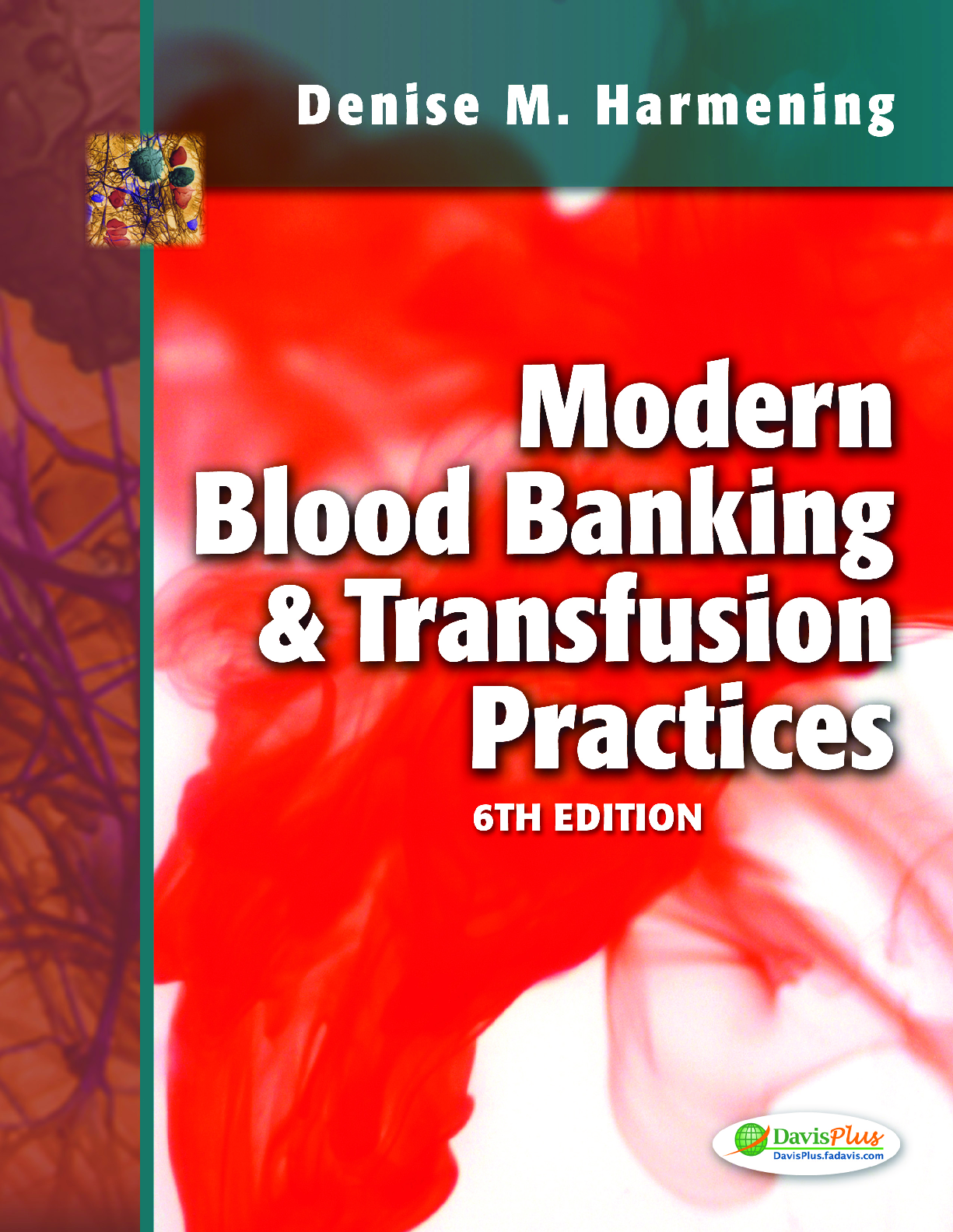
Buy this document to get the full access instantly
Instant Download Access after purchase
Add to cartInstant download
We Accept:

Reviews( 0 )
$15.00
Document information
Connected school, study & course
About the document
Uploaded On
Apr 20, 2021
Number of pages
669
Written in
Additional information
This document has been written for:
Uploaded
Apr 20, 2021
Downloads
0
Views
92


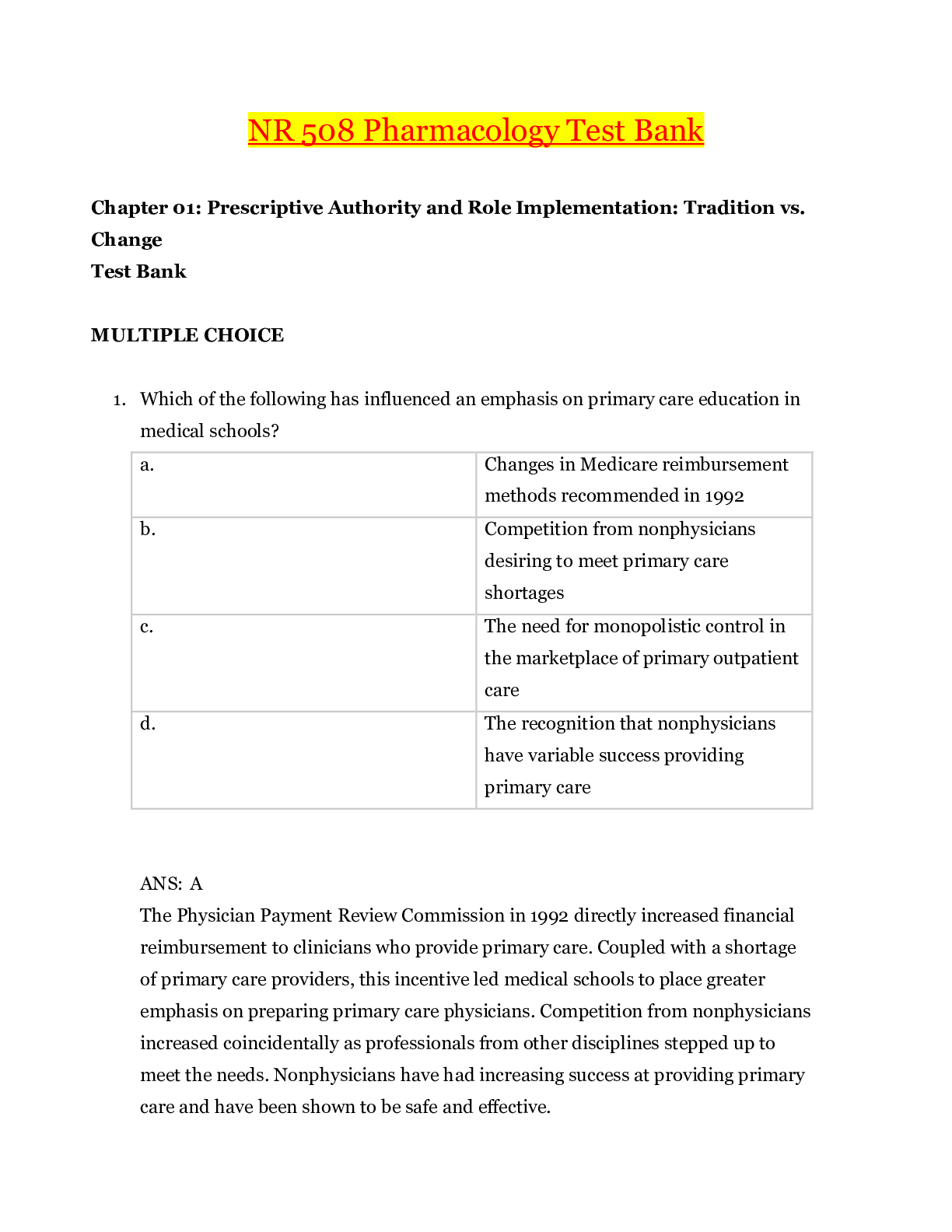
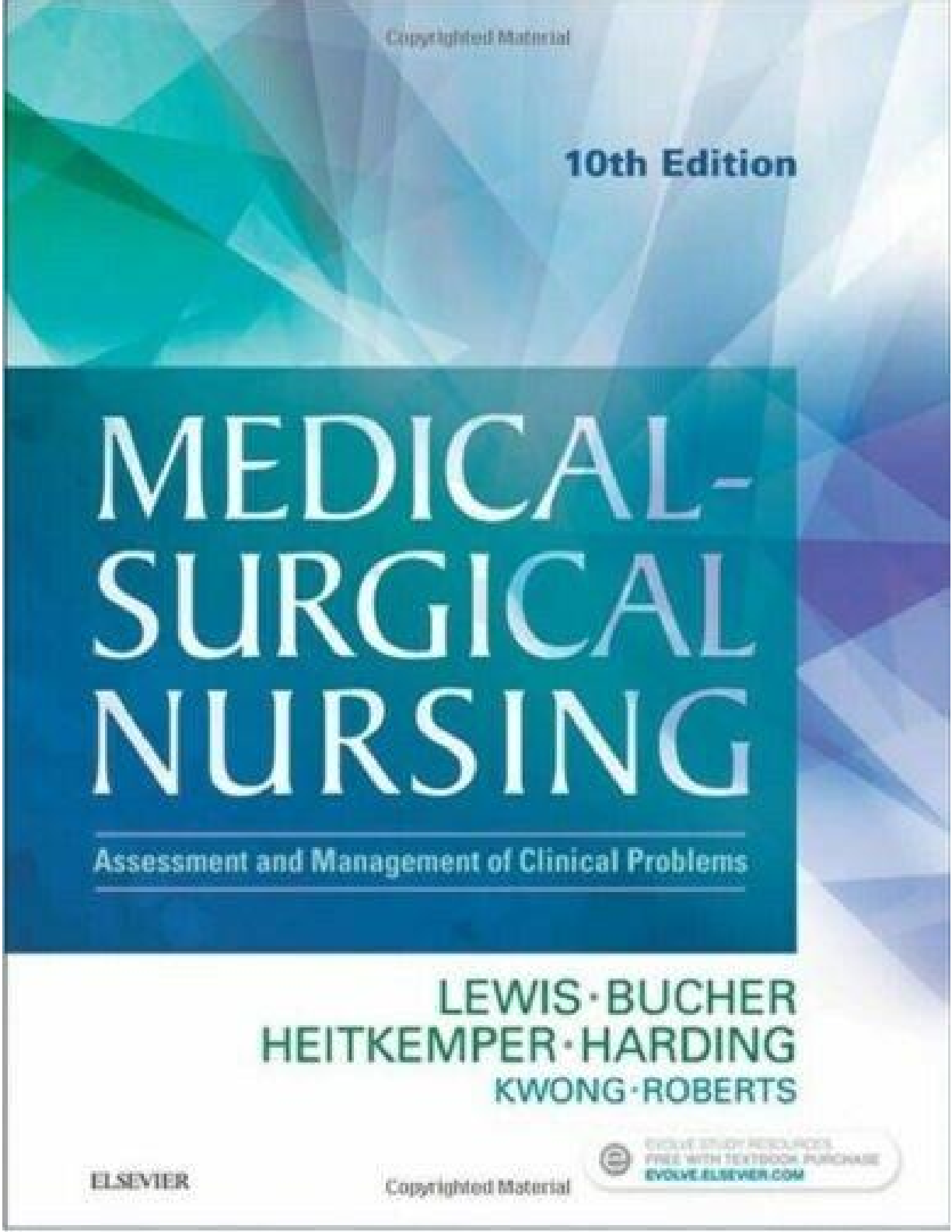

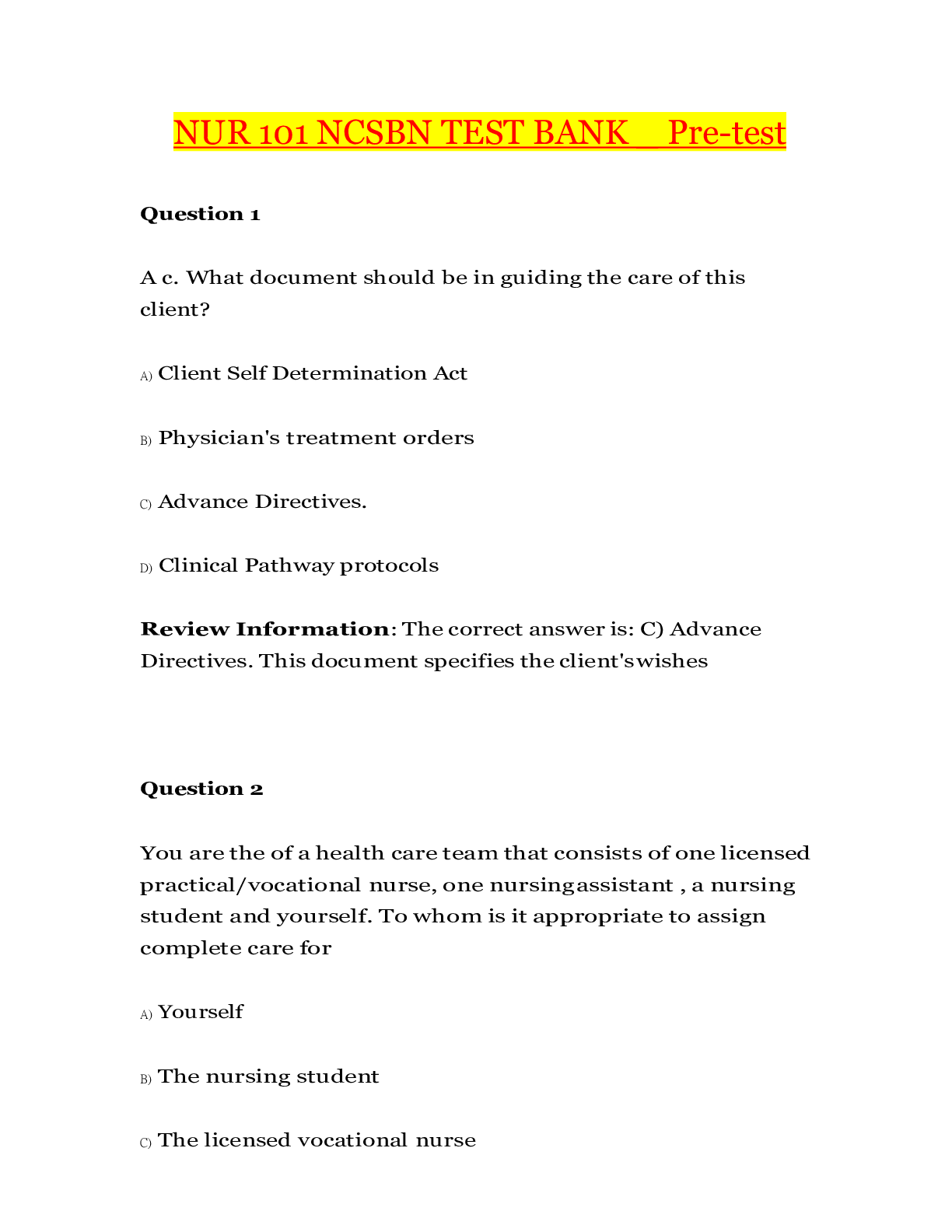
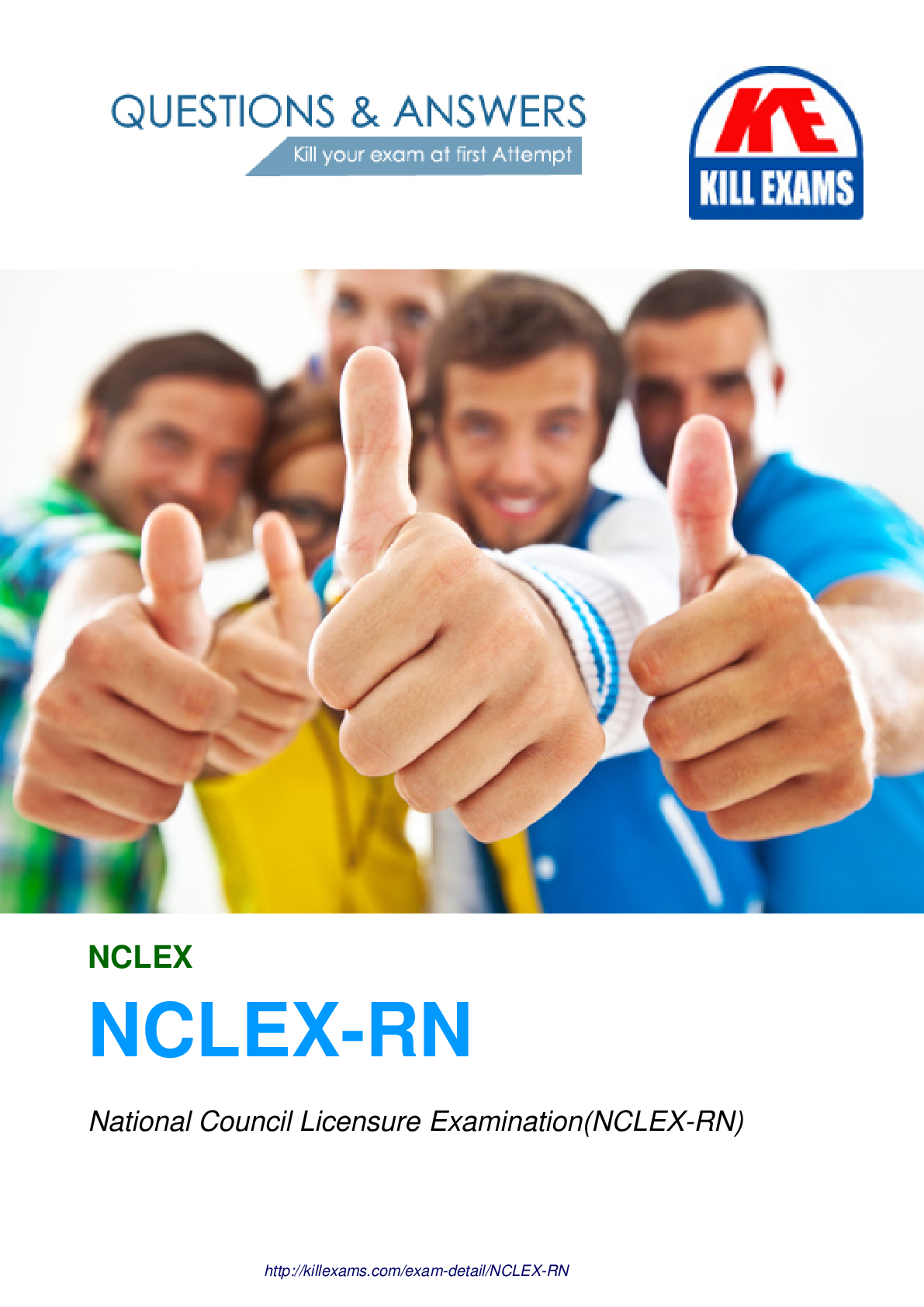



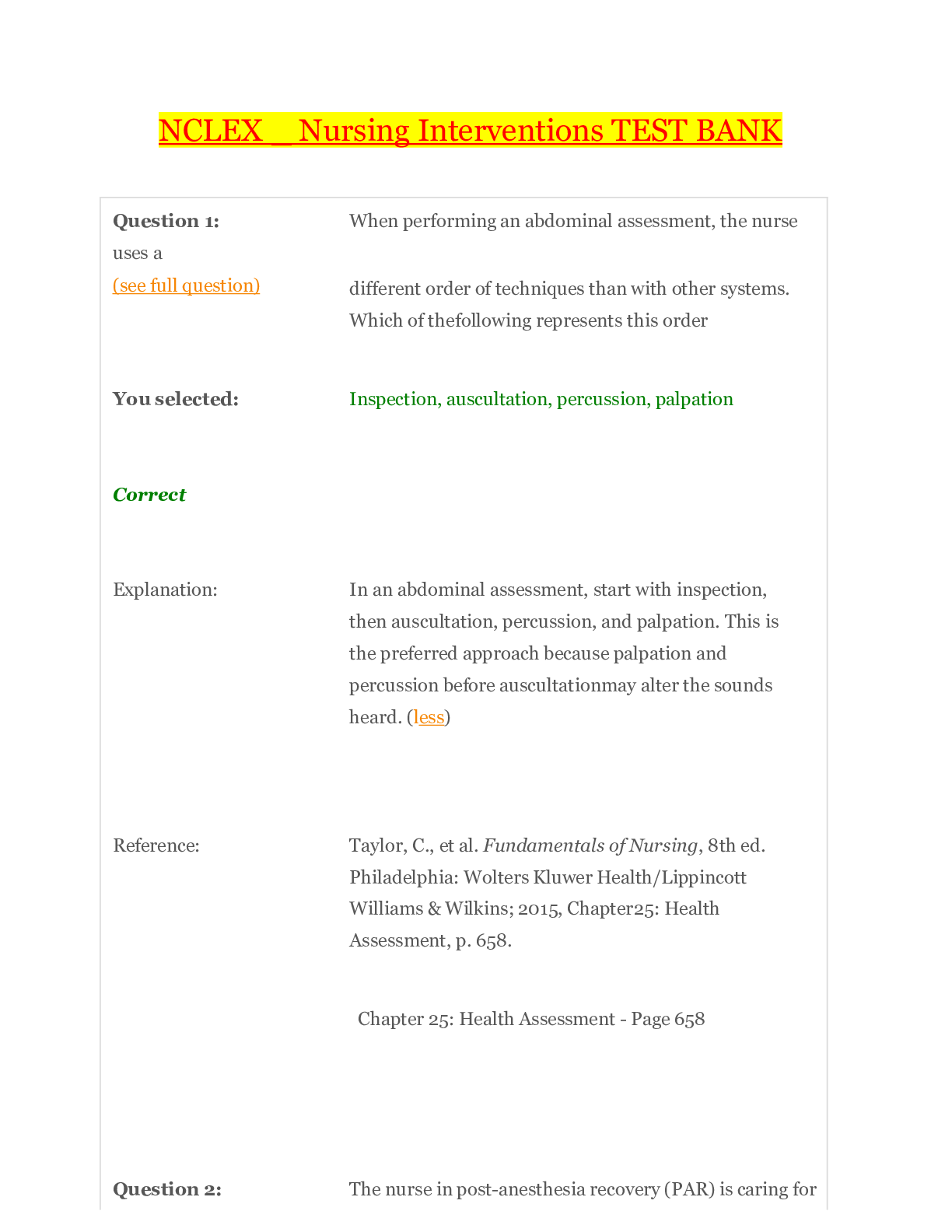


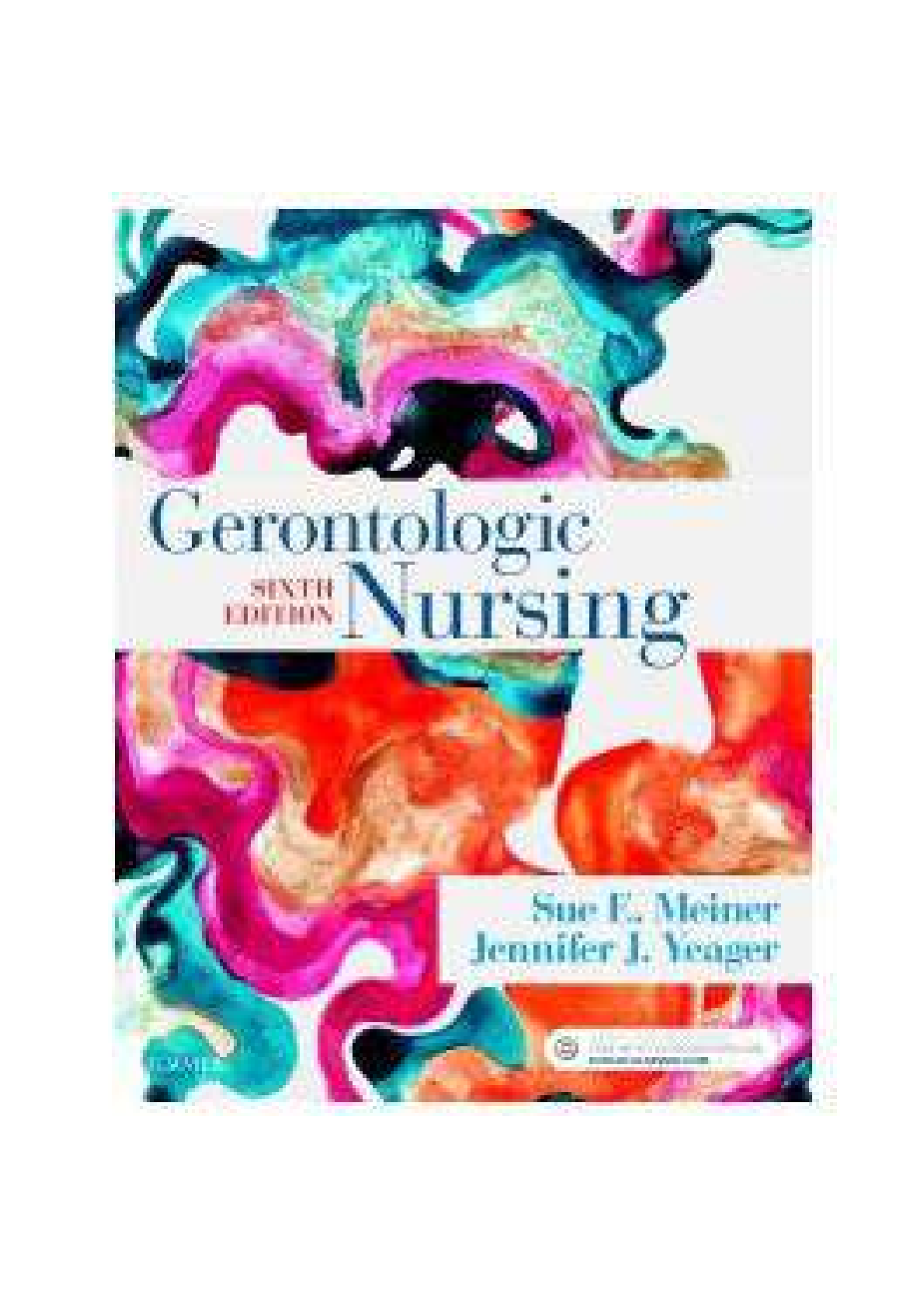

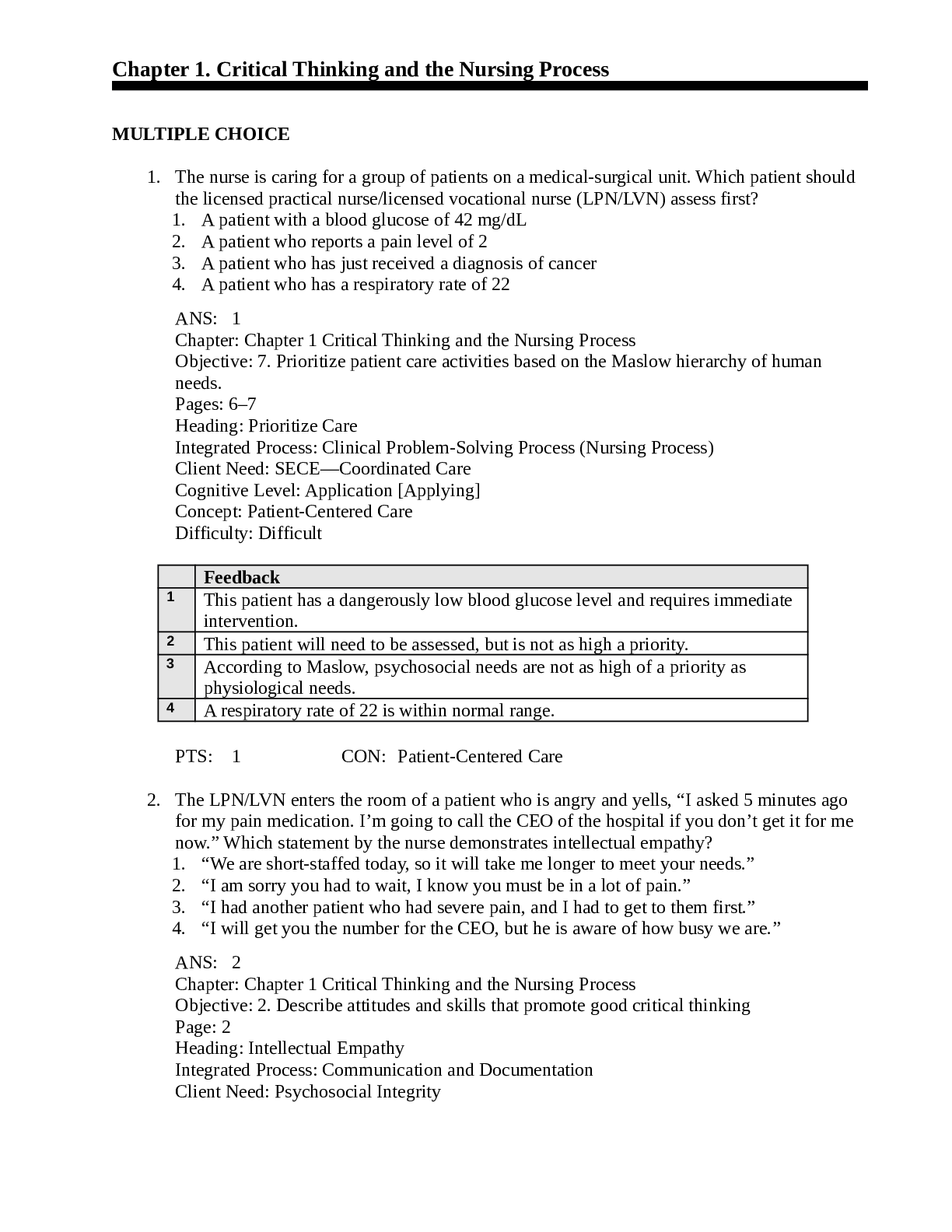
.png)
